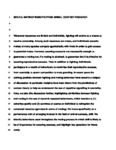Skilful mating? Insights from animal contest research
| dc.contributor.author | Lane, Sarah | |
| dc.contributor.author | Briffa, Mark | |
| dc.date.accessioned | 2021-11-09T15:40:08Z | |
| dc.date.available | 2021-11-09T15:40:08Z | |
| dc.date.issued | 2021-04-22 | |
| dc.identifier.issn | 0003-3472 | |
| dc.identifier.issn | 1095-8282 | |
| dc.identifier.uri | http://hdl.handle.net/10026.1/18282 | |
| dc.description.abstract |
Whenever resources are limited and indivisible, fighting will evolve as a means to resolve ownership. Among such resources are mates, and individuals (usually males) of many species compete agonistically with rivals in order to gain access to potential mates. However, securing access is not necessarily enough to guarantee a mating or, if a mating is obtained, to guarantee that it is effective for securing reproductive success. Thus, in addition to fighting, individuals participate in a wealth of behaviours to maximize their reproductive success, from courtship to sperm competition to mate guarding. In recent years, the striking parallels between fighting and mating behaviour have become a subject of discussion. In particular, insights have been drawn from the predictions of contest theory to help us understand the use of repetitive signalling in courtship. Here, we take this discussion further, highlighting similarities between fighting and mating in the use of dynamic repeated behaviours, which function to (1) advertise quality and (2) convince or coerce an individual to relinquish the contested resource (gametes in terms of mating). We focus specifically on a performance trait of emerging interest in the field of animal contests, skill. We identify behaviours used throughout the mating process in which skill is likely to be of importance for securing success, and highlight key questions for future study. | |
| dc.format.extent | 197-207 | |
| dc.language | en | |
| dc.language.iso | en | |
| dc.publisher | Elsevier BV | |
| dc.subject | conflict | |
| dc.subject | contest behaviour | |
| dc.subject | dynamic repeated behaviour | |
| dc.subject | fighting | |
| dc.subject | limited resource | |
| dc.subject | reproductive behaviour | |
| dc.subject | signalling | |
| dc.subject | skill | |
| dc.title | Skilful mating? Insights from animal contest research | |
| dc.type | journal-article | |
| dc.type | Review | |
| dc.type | Journal | |
| plymouth.author-url | https://www.webofscience.com/api/gateway?GWVersion=2&SrcApp=PARTNER_APP&SrcAuth=LinksAMR&KeyUT=WOS:000798541000018&DestLinkType=FullRecord&DestApp=ALL_WOS&UsrCustomerID=11bb513d99f797142bcfeffcc58ea008 | |
| plymouth.volume | 184 | |
| plymouth.publication-status | Published | |
| plymouth.journal | Animal Behaviour | |
| dc.identifier.doi | 10.1016/j.anbehav.2021.03.006 | |
| plymouth.organisational-group | /Plymouth | |
| plymouth.organisational-group | /Plymouth/Faculty of Science and Engineering | |
| plymouth.organisational-group | /Plymouth/Faculty of Science and Engineering/School of Biological and Marine Sciences | |
| plymouth.organisational-group | /Plymouth/REF 2021 Researchers by UoA | |
| plymouth.organisational-group | /Plymouth/REF 2021 Researchers by UoA/UoA04 Psychology, Psychiatry and Neuroscience | |
| plymouth.organisational-group | /Plymouth/Research Groups | |
| plymouth.organisational-group | /Plymouth/Research Groups/Marine Institute | |
| plymouth.organisational-group | /Plymouth/Users by role | |
| plymouth.organisational-group | /Plymouth/Users by role/Academics | |
| plymouth.organisational-group | /Plymouth/Users by role/Researchers in ResearchFish submission | |
| dcterms.dateAccepted | 2021-01-08 | |
| dc.rights.embargodate | 2022-4-22 | |
| dc.identifier.eissn | 1095-8282 | |
| dc.rights.embargoperiod | Not known | |
| rioxxterms.funder | Biotechnology and Biological Sciences Research Council | |
| rioxxterms.identifier.project | The role of skill in animal contests: Analysis of a neglected RHP trait in fighting hermit crabs | |
| rioxxterms.versionofrecord | 10.1016/j.anbehav.2021.03.006 | |
| rioxxterms.licenseref.uri | http://www.rioxx.net/licenses/all-rights-reserved | |
| rioxxterms.licenseref.startdate | 2021-04-22 | |
| rioxxterms.type | Journal Article/Review | |
| plymouth.funder | The role of skill in animal contests: Analysis of a neglected RHP trait in fighting hermit crabs::Biotechnology and Biological Sciences Research Council |


